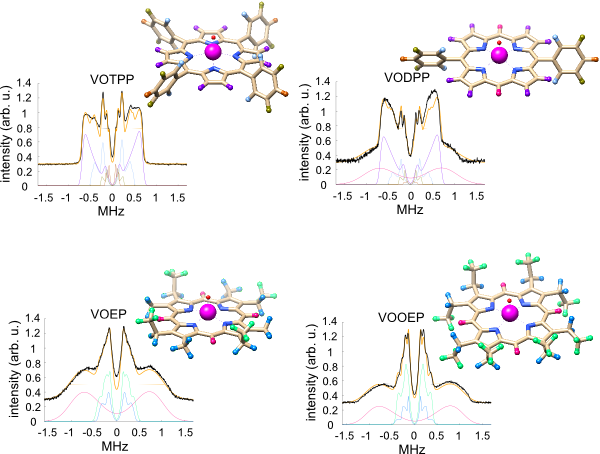Reports: DNI454860-DNI4: High-Resolution EPR Characterization of the Ligand Structure in Vanadium Porphyrin Complexes
Stefan Stoll, PhD, University of Washington
The goal of this project is to build a better understanding of the magnetic structure of vanadyl porphyrins using high-resolution Electron Paramagnetic Resonance (EPR) spectroscopy techniques. This will provide a new approach for the speciation of vanadyl porphyrin compounds in crude oil, a prerequisite for improving methods of removing vanadyl porphyrins, which is an ongoing problem in oil refining. High-resolution EPR spectroscopy can resolve variations in the structure of various porphyrin ligands via their magnetic signature.
In the first year of this project, we examined a series of model vanadyl compounds in order to develop and assess the resolving power of this approach. Specifically, we studied vanadyl tetraphenylporphyrin (VOTPP), vanadyl diphenylporphyrin (VODPP), vanadyl octaethylporphyrin (VOOEP) and vanadyl etioporphyrin (VOEP) (see Scheme 1). The major difference in the magnetic structure among these vanadyl porphyrins is in the sidechains attached to the porphyrin macrocycle frame.
Scheme 1: Structures of model vanadyl porphyrins
We used Q-band Mims Electron Nuclear Double Resonance (ENDOR), a pulse EPR technique, to resolve the magnetic hyperfine interaction between the unpaired 3d electron on V(IV) and the ligand protons. The ENDOR spectra are shown in Fig. 1. It is evident that the spectra differ strongly among the various porphyrins. This demonstrates that ENDOR can be used as a fingerprint technique for ligand speciation.
Figure 1: 1H ENDOR spectra of model vanadyl porphyrins. The horizontal axis shows the offset form the 1H Larmor frequency. Black: experimental data, ocre: simulation, remaining colors: simulations of spectral components due to individual protons. The ligand protons of the inset structures are color coded as their corresponding spectral components.
We were able to assign spectral features to chemically distinct protons by a combination of spectral simulations and quantum chemical calculations. These assignments are shown in Fig. 1. Both VOTPP and VODPP have pyrrolic, ortho, meta and para protons in common and the spectral simulations were made with equivalent parameters. The spectra of VOEP, and VOOEP have features due to the methyl and ethyl ligands in these porphyrins. The peak positions for these methyl and ethyl protons are equivalent as well. VOEP, VOOEP, and VODPP have a broad meso proton feature. Importantly, we are able to analyze the spectral intensity for each chemically distinct group of protons and extract the number of the protons in that group. Therefore, ENDOR spectra allow proton counting and chemical speciation of the porphyrin ligand.
In summary, the ENDOR results show that we can resolve the individual proton couplings and that we can determine the number of protons. In the second year of the project, we will investigate more complicated porphyrin compounds, their mixtures, and samples of crude oil. Additionally we will pursue methods to further improve the spectral resolution.













